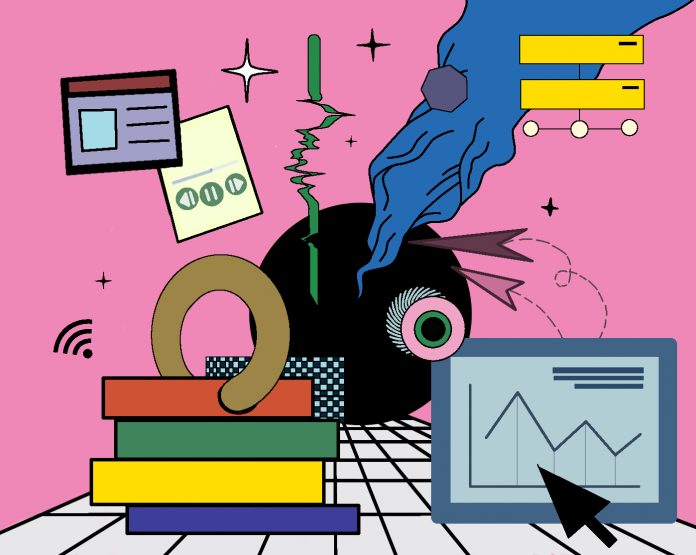The current policy thrust on a Digital India Campaign aims to transform the nation into a digitally empowered knowledge based economy and society. To actualize this vision NEP 2020 recommends the use of educational technology in the improvement of educational processes and outcomes (GoI, 2020). The state think-tank NITI Aayog recognizes as also emphasizes the significant role of technology oriented solutions (NITI Aayog, 2017). The fetish with technology in social and economic life is not novel. In the mid 1980’s ‘taking India to the 21st century’ was a key slogan of the then government. In alignment the NPE 1986/1992 highlighted the need of information and educational technology to improve the quality of education at all levels. NEP 2020 carries this oracular emphasis much further. It puts the spotlight on digital pedagogies as a major reform in school and higher education.
The roadmap for an impending digital transformation in schools that policy was laying since decades finally occurred overnight in March 2020. The transformation was necessitated due to nation- wide campus closure. The inevitable shift to online education took place since the only other alternative seemed to be not to teach. The period since March 2020 has since been one of unprecedented transition for education. The prolonged school closure has caused discontinuity, disruption and uncertainty in the existing institutional arrangements for education as schooling, teaching and learning has shifted online. Online education which was introduced as a transitory, ad hoc and short-term measure has turned into a far more tenacious, near-permanent and enduring phenomenon. This is true for all levels of education: elementary, tertiary and teacher education. Edtech is central to this process of onlinisation through the introduction of new-age digital platforms, software applications, multi-media tools and online pedagogies.
Even as schools open for in-person learning edtech continues to have a promising future as it re-shapes the mainstream educational practice. There is a reboot of teaching through technology as ideas like remote learning, hybrid education and MOOC’s supplement traditional approaches. These are becoming a part of prevailing teaching-learning practice even as schools are opening up but edtech continues inroads into the mainstream at an unprecedented pace. The flourishing edtech companies are the new players in education. It is no exaggeration to say that there has been a metamorphosis of the entire education system.
The logic of ensuring continuity with the closure period has been touted as among the rationale for greater use of edtech in school education. Both in policy parlance and school practice the impact of edtech is on the ascent. Education is being reimagined in accordance with technological innovations. An edtech-driven learning programme was announced by Niti Aayog in association with a private start up player BYJU’s in September 2021 for children from 112 aspirational districts of the country (The Economic Times, 2021). The latter is a gigantic new company, a leading player in the edtech power network which is now shaping school pedagogical practice with policy support from a state body. Teachers in schools are drawing instructional materials from such edtech initiatives highlighting how profoundly such technologies are affecting teaching-learning practices in education at all levels.
Tech-votaries are further arguing that datafication and analytics are capable of replacing teachers for assessing needs of student and designing teaching learning models based upon student needs. Not only private players are seeking commercial activity in short term but are actively constructing a new imagination capitalized on edtech solutions. New York State Governor Andrew Cuomo went as far as to say
The old model of everybody goes and sits in a classroom and the teacher is in front of that classroom, and teaches that class, and you do that all across the city, all across the state, all these buildings, all these physical classrooms – why, with all the technology you have? (Williamson, 2020).
The edtech alternative is coming close to dismantling the existing system of schooling and replacing it with
human-less, contactless technologies’, artificial intelligence, public-private partnerships and extensive outsourcing of government functions, such as state schooling, to Silicon Valley businesses (Ibid).
Consequences for teacher education
This dystopian imaginary reads as far-fetched but is playing out in teacher education arena. Teachers are supposed to be the backbone of the education system’s edifice but edtech is at the cusp of creating an altogether new private infrastructure of public education. These transformative imaginaries are becoming important in policy as well as practice. The classroom in this new educational imagination is different as it is moving to an online format. In this different classroom the meaning of pedagogical preparation for student-teachers includes skill at creation of content to supplement, or, replace classroom teaching. Against this background student-teachers are worried about their own professional preparedness due to lack of formal training in edtech. The fear of being left behind was real as teacher education curriculum is mainly designed for equipping student-teachers for teaching in the face-to-face mode. Shaded by these concerns student-teachers seek out an experience of developing and teaching online to feignedly revitalize the ascent of edtech-driven education. In any case the school internship which is a major part of the teacher education curriculum has moved online in most teacher education institutions essentialising an engagement with learning how technology works during online pedagogies.
The article authors interacted with some of the student-teachers enrolled in a hands-on short programme at a small edtech enterprise in the processes of digital learning and tools. The focus was on exploring their understanding of the use of edtech in school education The edtech company mandated a defined curriculum, a tightly framed timeline, pre-written word script and so called engaging necessities of sending a fixed number of GIFs and emojis while chatting with students so as to their edtech platform turns into an appealing teaching-learning activity. The tight framing of both the subject taught and the pre-defined time in which it was to be taught was against Emerson’s dictum Adopt the pace of nature, her secret is patience. The experience of one of the training participants is that
these platforms are posing teachers as their educational market agents which primarily focus on selling education rather than providing education.
The training also includes innovating lesson plans and pedagogical strategies for creating engaging digital classrooms for elementary grades school curriculum. But with the pre-defined, pre-planned and limited homogenizing curriculum the teaching role is reduced mainly to mere content delivery. The algorithms of the edtech engines even go as far as to suggest topics, lessons and specific audio-visual content for teaching. Pre service teacher education is the period for development of pedagogical competence, curriculum planning and teacher agency. But this experience of training in digital pedagogies was one in which there was a loss of teacher agency.
Another student-teacher reported
mimicry behaviour is expected and online restraints are apparently causing static responses, clearly impacting on the way we tend to educate. There is an eerie someone watching over you, making suggestions to you… all the time. The focus is on content delivery with gimmickry embedded in the platform, and its retailing. The educational aspects and even the empirical socialization of student-teachers into a professional space is sorely missing.
Are private edtech companies going to shade the very role of the teacher?
For the final year students of the teacher education programme in our department in the previous academic session, 2020-21, the school internship was in the online format. Edtech was just beginning to ascend on school practices. The experience of subversion of teaching agency was not much different, as is evident with the words,
Teaching turned into a chore with a lack of intellectual excitement. This monotony that rules a virtual classroom can be lethal to all the curiosities, interests, and willingness to learn…Technology has in some quarters been viewed as a panacea to bring some gimmickry with learning, but… even after spending quite a number of months engaging with virtual learning and with digitalization… There was a lack of meaning-making as in the online teaching everything seemed decontextualized (Raina and Srivastava, 2021).
Chillingly appropriate is the forewarning that
There is no question of man rejecting technology. The question is only one of adaptation, direction and control. There may not be much time, and the only hope would seem to lie in education-the true education of free men capable of mastering technology rather than being enslaved by it, or by others in its name (Reimer, 1971).
It is noteworthy that edtech prepared content mimics an actual face-to-face classroom even though the nature of communication has changed. The school system in its tenacity has not re-looked at the curriculum, pedagogy or aims of education suited to the altered mode of communication but merely shifted from a physical space to a pixelated rectangle of a computer screen.
Sharp digital divide
Education through edtech continues to remain an exclusive privilege of students in the higher echelons of socio-economic class which overlaps with regional disparities in India. For example in Bihar half of the children do not have any access to a smartphone while in the states of Punjab, Himachal Pradesh and Kerala more than 97% children are equipped with the digital necessities of an online education.
Apart from a divide in availability of digital infrastructure there are wide regional disparities in educational facilities across the states. Kerala has 89% students using traditional sources for learning at home while the same statistic for Jharkhand stands at 44%. Kerala also has 91% (highest in the country) usage of online resources for home learning while Bihar has the lowest at 10.1%. Nationally only a quarter of the students depend on online learning and one-fifth use the broadcast media (Editorial, EPW, 2021).
The enthrallment with edtech comes not only with dystopian prospects of dependence of education on competitive consumption of ‘content’, alias knowledge as a product, in the name of elearning but also exacerbating existing educational inequality. Where is the road for escape for beginning student-teachers who are waiting to enter the edtech oriented education system as school becomes the ‘universal church of a technological society’, shaping minds to incorporate and transmit a techno-economistic ideology?
Supriya Rathi is pursuing her undergraduate research project on this theme under the supervision of Dr. Jyoti Raina at the Department of Elementary Education, Gargi College, University of Delhi, Delhi.














